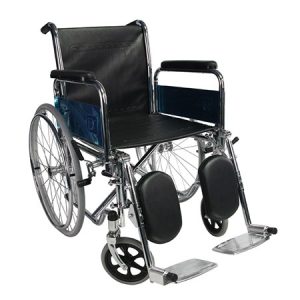WALKING AID
A WALKING AID
is one of the several device a patient maybe issued in order to improve their walking pattern and balance.
It can be a means of transferring eight from the upper limb to the ground where reducing bearing through the lower limb is desired.

CATEGORIES OF WALKING AID
- Canes or walking sticks
2. Crutches
3. Walkers
4. Standing aids
DESCRIPTORS OF WEIGHT BEARING STATUS
Full weight bearing: There are no restrictions and client can bear 100% body weight on the lower extremities.
Non-weight bearing: No weight is borne on the involved limb
Partial weight bearing: Client is allowed to bear only a portion of body weight on.
Lower extremities (expressed as a percentage of body weight
Toe touch weight bearing: Only the toes of the affected extremity contact the floor to improve balance
TYPES OF MOBILITY AIDS
Canes: support the body’s weight and help transmit the load from the legs to the upper body.
There are three main types of canes:
Single-point C: A cane is the simplest way to lend some support to the leg
Quad cane: it is a good option for people who need more stability
White canes: They are mostly used by blind.
Crutches: It allow you to completely remove weight from the extremity, they require good stability and upper body strength, if you have been treated for an injury or had surgery
Types of Crutches
Axillary crutches: One part of the crutch is placed against the rib cage under the armpits while the patient holds onto the hand grip
Lofstrand (forearm) crutches: It involves placing the arm into a metal or plastic cuff and holding a hand grip.
Platform crutches: The hand holds a grip while the forearm rest
Types Walkers
Rollators: It consist of a frame with four wheels, hand brakes for safety features, handlebars and a seat the user can rest as needed,

Walker-cane hybrids: A cross between a cane and a walker it has to legs rather than a frame. It can be used with one or both hands to provide a greater support than a standard cane.
Wheelchair
It is basically used by people who should not put weight on their lower limbs or who are unable to walk, it can be more stable for people with severe disability and great for long distance travel.
Mobility Scooters: Has handlebars or steering wheels to control directions, users feet rest on foot plates, they are powered by a battery, can be beneficial for those without upper body strength or flexibility to use a manual wheelchair and can’t afford a motorized wheelchair.

Who can benefit from mobility aids
1. Arthritis
2. Celebral Palsy
3. Development disabilities
4. Diabetic ulcers and wounds
5. Gout
